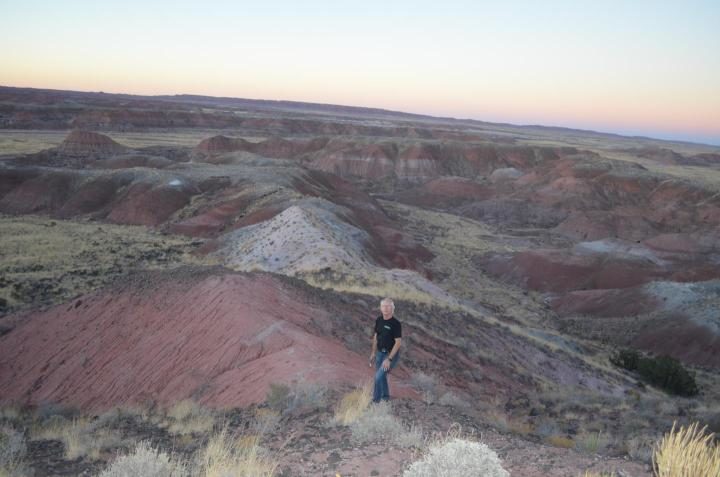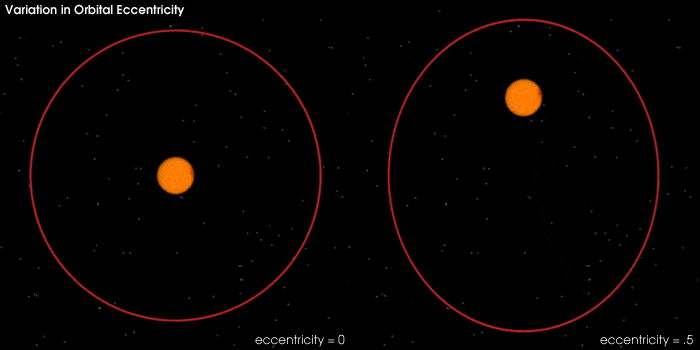
Scientists drilling deep into ancient rocks in the Arizona desert say they have documented a gradual shift in Earth's orbit that repeats regularly every 405,000 years, playing a role in natural climate swings. Astrophysicists have long hypothesized that the cycle exists based on calculations of celestial mechanics, but the authors of the new research have found the first verifiable physical evidence. They showed that the cycle has been stable for hundreds of millions of years, from before the rise of dinosaurs, and is still active today. The research may have implications not only for climate studies, but our understanding of the evolution of life on Earth, and the evolution of the Solar System. It appears this week in the Proceedings of the National Academy of Sciences.
Scientists have for decades posited that Earth's orbit around the sun goes from nearly circular to about 5 percent elliptical, and back again every 405,000 years. The shift is believed to result from a complex interplay with the gravitational influences of Venus and Jupiter, along with other bodies in the Solar System as they all whirl around the Sun like a set of gyrating hula-hoops, sometimes closer to one another, sometimes further. Astrophysicists believe the mathematical calculation of the cycle is reliable back to around 50 million years, but after that, the problem gets too complex, because too many shifting motions are at play.
"There are other, shorter, orbital cycles, but when you look into the past, it's very difficult to know which one you're dealing with at any one time, because they change over time," said lead author Dennis Kent, an expert in paleomagnetism at Columbia University's Lamont-Doherty Earth Observatory and Rutgers University. "The beauty of this one is that it stands alone. It doesn't change. All the other ones move over it."The new evidence lies within 1,500-foot-long cores of rock that Kent and his coauthors drilled from a butte in Arizona's Petrified Forest National Park in 2013, plus earlier deep cores from suburban New York and New Jersey. The Arizona rocks in the study formed during the late Triassic, between 209 million and 215 million years ago, when the area was covered with meandering rivers that laid down sediments. Around this time, early dinosaurs started evolving.
The scientists nailed down the Arizona rocks' ages by analyzing interspersed volcanic ash layers containing radioisotopes that decay at a predictable rate. Within the sediments, they also detected repeated reversals in the polarity of the planet's magnetic field. The team then compared these findings to the New York-New Jersey cores, which penetrated old lakebeds and soils that hold exquisitely preserved signs of alternating wet and dry periods during what was believed to be the same time.
Kent and Olsen have long argued that the climate changes displayed in the New York-New Jersey rocks were controlled by the 405,000-year cycle. However, there are no volcanic ash layers there to provide precise dates. But those cores do contain polarity reversals similar to those spotted in Arizona. By combining the two sets of data, the team showed that both sites developed at the same time, and that the 405,000-year interval indeed exerts a kind of master control over climate swings. Paleontologist Paul Olsen, a coauthor of the study, said that the cycle does not directly change climate; rather it intensifies or dampens the effects of shorter-term cycles, which act more directly.
The planetary motions that spur climate swings are known as Milankovitch cycles, named for the Serbian mathematician who worked them out in the 1920s. Boiled down to simplest terms, they consist of a 100,000-year cycle in the eccentricity of Earth's orbit, similar to the big 405,000-year swing; a 41,000-year cycle in the tilt of Earth's axis relative to its orbit around the Sun; and a 21,000-year cycle caused by a wobble of the planet's axis. Together, these shifts change the proportions of solar energy reaching the Northern Hemisphere, where most of the planet's land is located, during different parts of the year. This in turn influences climate.
In the 1970s, scientists showed that that Milankovitch cycles have driven repeated warming and cooling of the planet, and thus the waxing and waning of ice ages over the last few million years. But they are still arguing over inconsistencies in data over that period, and the cycles' relationships to rising and falling levels of carbon dioxide, the other apparent master climate control. Understanding how this all worked in the more distant past is even harder. For one, the frequencies of the shorter cycles have almost certainly changed over time, but no one can say exactly by how much. For another, the cycles are all constantly proceeding against each other. Sometimes some are out of phase with others, and they tend to cancel each other out; at others, several may line up with each other to initiate sudden, drastic changes. Making the calculation of how they all might fit together gets harder the further back you go.
Kent and Olsen say that every 405,000 years, when orbital eccentricity is at its peak, seasonal differences caused by shorter cycles will become more intense; summers are hotter and winters colder; dry times drier, wet times wetter.
The eccentricity of the Earth's orbit changes slowly over time from nearly zero to 0.07. As the orbit gets more eccentric (oval) the difference between the distance from the Sun to the Earth at perihelion (closest approach) and aphelion (furthest away) becomes greater and greater. Note that the Sun is not at the center of the Earth's orbital ellipse, rather it is at one of focal points. Note: The eccentricity of the orbit shown in the right image is a highly exaggerated 0.5. Even the maximum eccentricity of the Earth's orbit-0.07-it would be impossible to show at the resolution of a web page. Even so, at the current eccentricity of .017, the Earth is 5 million kilometers closer to Sun at perihelion than at aphelion.

Jupiter and Venus exert such strong influences because of size and proximity. Venus is the nearest planet to us -- at its farthest, only about 162 million miles -- and roughly similar in mass. Jupiter is much farther away, but is the Solar System's largest planet, 2.5 times bigger than all others combined.
Linda Hinnov, a professor at George Mason University who studies the deep past, said the new study lends support to previous studies by others that claim to have observed signs of the 405,000-year cycle even further back, before 250 million years ago.
Among other things, she said, it "could lead to new insights into early dinosaur evolution." She called the findings "a significant new contribution to geology, and to astronomy."Kent and Olsen say that because of all the competing factors at work, there is still much to learn. "This is truly complicated stuff," said Olsen. "We are using basically the same kinds of math to send spaceships to Mars, and sure, that works. But once you start extending interplanetary motions back in time and tie that to cause and effect in climate, we can't claim that we understand how it all works." The metronomic beat of the 405,000-year cycle may eventually help researchers disentangle some of this, he said.
If you were wondering, the Earth is currently in the nearly circular part of the 405,000-year period. What does that mean for us? "Probably not anything very perceptible," says Kent. "It's pretty far down on the list of so many other things that can affect climate on times scales that matter to us." Kent points out that according to the Milankovitch theory, we should be at the peak of a 20,000-some year warming trend that ended the last glacial period; the Earth may eventually start cooling again over thousands of years, and possibly head for another glaciation. "Could happen. Guess we could wait around and see," said Kent. "On the other hand, all the CO2 we're pouring into the air right now is the obvious big enchilada. That's having an effect we can measure right now. The planetary cycle is a little more subtle."



That is what the ice cores actually say. Up or down.